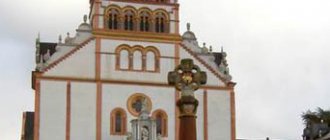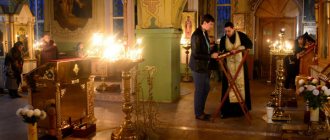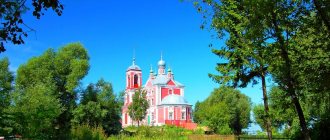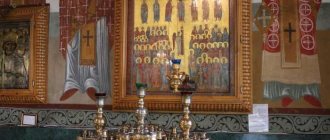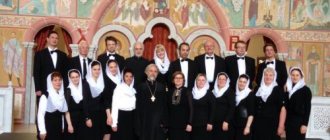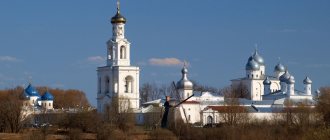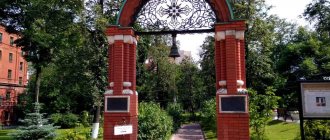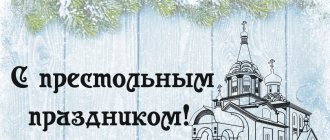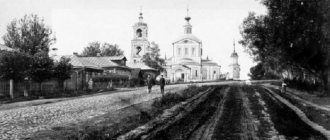History of the temple
In 1551, before the decisive assault on Kazan, Ivan IV the Terrible ordered the construction of a fortress in Sviyazhsk. In addition to a wooden fort and barracks for soldiers, the first parish church was erected in the new settlement. According to legend, the Russian sovereign himself chose the place for it. When the small wooden church was completed, it was dedicated to the Equal-to-the-Apostles kings Constantine and Helena.
View of the Church of Saints Constantine and Helena from Moskovskaya Street
It is known that the first priest of the temple was Father German, who created the Sviyazhsk Mother of God Assumption Monastery
. In 1564, the high priest of the city accepted the title of archbishop and moved to Kazan.
The earliest record of the Sviyazhsk church dates back to 1568. 17 years after its founding, it was mentioned among the nine parish churches of Sviyazhsk in the scribe book. An ancient document records that the church stood “on the square, opposite the large Nativity Gate.”
View of the Church of Saints Constantine and Helena from Bolotnaya Street
In the middle of the 16th century, all city buildings were made of wood. Over time, the church became dilapidated and they decided to replace it with a stone one. It is believed that the new temple was built at the end of the 17th or beginning of the 18th century. Then the bell tower stood separately from the building.
The temple had three thrones. The main one was dedicated to Constantine and Helena, the southern one to the Christian theologian and preacher Andrei of Crete, and the northern one to the Bishop of Rostov and Suzdal Leonty. In the parable there were three priests, a baker, a sexton and a church watchman. All of them received cash and grain salaries from the treasury, so the church was “ruzhka”.
View of the Church of Saints Constantine and Helena from the Volga
She was on the border of the city. To the west of the temple, the Sviyazhsk fortifications rose, and below there was a settlement where there were workshops of artisans and houses of the townspeople. At the beginning of the 18th century, the building acquired its modern appearance - the bell tower and the main volume were connected by a squat refectory, and in 1855 the temple was assigned to the main city cathedral.
At the end of the 19th and beginning of the 20th centuries, the Sviyazhsk church flourished. With money from the diocese and benefactors, two chapels and a chapel on the south side were built. It is known that local merchant N.I. donated large sums for the needs of the temple. Savrasova. Two altars were consecrated in the church - in honor of St. George the Victorious, the icon of Our Lady of Vladimir and Constantine and Helen revered by believers.
View of the entrance and bell tower of the Church of Saints Constantine and Helena
With the advent of Soviet power, the situation changed. In all parts of the state, including Kazan, religious organizations began to be actively oppressed. Despite the policy of atheism pursued in the country, the Sviyazhsk church was not touched for a long time. Then the northern aisle was lost, and in 1929 the small chapel was destroyed.
The churches and monasteries of the diocese disappeared one after another. Many buildings were blown up and dismantled for building materials, and people came to services in the ancient church without hindrance. This continued until 1939, when the rector, Priest Anatoly Romanovsky, served the last prayer service. After this, the Sviyazhsk temple was closed.
General view of the Church of Saints Constantine and Helena
At first, the solid stone building was converted into a blacksmith shop, and then into a warehouse. In the 1980s and early 1990s, the former temple was considered a branch of the State Museum of the Tatar Autonomous Soviet Socialist Republic, so museum displays were housed inside and exhibitions were held.
Finally, at the request of the Christian community of Sviyazhsk, the building was returned to the Church. After a long break, the first service was held at the beginning of June 1993.
Parishioners, volunteers and builders began large-scale restoration. In 1994, when clearing the area north of the church, two burials with many human remains were found. The innocent victims were reburied in a common grave, and a large worship cross was placed over it.
Bell tower
The Campanile was built in the XII-XIII centuries. from the southern facade of the Verona Cathedral. The building reaches 75 m in height and is the second “skyscraper” in the city after the Lamberti tower, rising 83 m. The thickness of the masonry is 3.1 m, the size of the sides in plan is 10-11 m. The original project, developed by Michele Sanmicheli, was subsequently modified by his nephew Bernardino Brugnoli. The upper part, where there are 10 tuned bells, was built at the beginning of the 20th century. designed by Ettore Fagiuoli. The bell melodies using the “campane alla veronese” technique are played manually by a team of twenty people.
Travelers like:
Architectural features
The ancient church is rightfully considered one of the attractions of the Republic of Tatarstan. After the high Nativity Cathedral was destroyed in the 1930s, it became the compositional center of the eastern part of the island. Snow-white walls and shiny domes attract the eye! A particularly magnificent view of the temple opens to everyone who gets to Sviyazhsk by water.
Worship cross at the burial site
The brick building was erected in the best traditions of Russian temple architecture of the late 17th – early 18th centuries. The three-part pillarless “ship” structure consists of a temple part, a refectory and a bell tower, which are stretched in one line - from east to west.
The laconic quadrangle of the church has box and tray vaults. On top of it rises a blank drum with a neat onion-shaped head. A three-lobed apse adjoins the building from the east. Since the temple stands on a slope, the apse is located below the main volume.
The low, one-story refectory has box vaults and a gable roof. To the west of it stands a beautiful three-tiered bell tower. The two lower tiers look like quadrangles. Above is an octagonal belfry with arched openings, and the building is crowned by a low spherical dome and a blank drum with a gilded onion dome.
The decorative decoration of the church traces the traditions of ancient Russian stone architecture and Baroque elements. The semi-columns and pediments on the window frames are stylized as cockscombs, and the cornice is decorated with brackets in the form of steps.
View of the baptismal
To the north of the temple there is a small baptismal church, which appeared in 2010-2012. From the south you can see an elegant chapel, built according to the design of the architect E.V. Ignatiev with money from the Revival charitable foundation. The chapel is designed in the style of a temple, so they complement each other perfectly. The small area is surrounded by a low fence on stone pillars.
Architecture of the main cathedral of Verona
The massive entrance portal of the cathedral, considered the last known work of Niccolò (circa 1139), is decorated with the figures of the saints and paladins Roland and Olivier. The lunette features polychrome relief images of the Virgin Mary seated on a throne with a baby in her arms, and scenes of the Announcement to the Shepherds and the Adoration of the Magi. Under them you can see medallions with allegories of the Virtues - Faith, Hope, Love. On the second level there is a clock, above there is a rose window.
One of the griffons © Patrice78500 / Wikimedia Commons
On the porch of the main entrance to the Duomo rest two griffins supporting twisted columns. Nearby there is a modern bronze sculpture of an Angel , inviting you to enter the cathedral and often acting as a backdrop for tourist selfies. A more modest side portal of the Verona Cathedral from the Via Pietà Vecchia appeared later.
Interiors and shrines
The inside of the church is very cozy, and you immediately feel at home. A three-tier iconostasis is installed in the eastern part. Most of the icons are new. Some were written by Father Sergius (Korobtsev), who has led the local community since 1995.
The oldest icon is considered to be “The Lord of Hosts,” which art historians date back to the 18th century. There are several 19th century icons in the church. Believers come here to pray in front of Orthodox shrines - the Sviyazhsk Icon of the Mother of God, the image of Sergius of Radonezh, revered in Russia, and the icon with a particle of the relics of St. Herman of Kazan.
Baptistery of San Giovanni in Fonte
The religious building is often called the Church of San Giovanni in Fonte . The earlier building was destroyed in an earthquake in 1117 and rebuilt in Romanesque style in 1123. The baptistery has a gabled facade, a simple entrance portal and lancet windows. The interior space is divided into three naves by rows of columns with capitals and arches resting on them. The naves end with apses with spherical semi-domes. On the walls you can see a few fragments of ancient frescoes, in particular, in the right apse there is an image of the Madonna della Misericordia .
Font with bas-reliefs © chieseverona.it
In the center of the main nave there is a monumental baptismal font , made at the end of the 12th century. Verona architect and sculptor Brioloto de Balneo. It has 8 sides, decorated with blind hanging arches, twisted columns and bas-reliefs with biblical scenes. The first thing that appears before those entering the Baptistery is the scene of the Baptism of Christ . Then - counterclockwise you can see:
- Annunciation;
- Nativity;
- Announcement to the Shepherds;
- Adoration of the Magi;
- Herod with soldiers;
- Massacre of the innocents;
- Flight to Egypt.
Useful information for pilgrims and tourists
Today the ancient church is active. Here they confess, marry, baptize and see off on their last journey. Children from Sviyazhsk attend Sunday school. Local residents call their favorite parish church Tsarekonstantinovsky or Konstantinoleninsky.
Interior of the Church of Saints Constantine and Helena
The doors of the church are open to everyone from morning to evening. Divine services are held on Sundays and holidays at 8:00 and 16:30, and in winter - at 9:00 and 15:00. The patronal feast day in the church is celebrated on July 11.
Recommendations
- "National Register Information System". National Register of Historic Places
. National Park Service. March 15, 2006 - "Saint Helen's Cathedral" Visit Helena Montana
. Retrieved October 25, 2016. - Jackson, Nicholas (ed.). "Saint Helen's Cathedral" Atlas Obscura
. Retrieved September 22, 2016. - ^ a b
Regan 2012, para. 177. - Talwani, Sanjay (25 November 2015). "History shares space with biblical images in the stained glass windows of Helen's Cathedral." Montana Standard
. Retrieved October 25, 2016. - ^ a b c
Spencer 2002, para. 102.
How to get there
The landmark of Sviyazhsk is located on the northeastern tip of the island. The temple stands 150 m from the shore, at the intersection of Konstantinovskaya, Uspenskaya, Moskovskaya and Bolotnaya streets. If you travel by car, from Kazan you need to take the M-7 highway towards the Russian capital. At the junction, after the road bridge over the Sviyaga River, turn right at the sign “Sviyazhsk”, and after 11.5 km you will be there.
Iconostasis of the Church of Saints Constantine and Helena
The island has the status of a museum-reserve. Outside cars are not allowed there, so you need to park in a guarded parking lot before entering Sviyazhsk. Walk along Uspenskaya Street, and after 1 km it will lead you to the temple.
In summer, during the navigation season, it is convenient to travel from Kazan to the island by boat. The journey by water takes two hours. The church is located within walking distance from the Sviyazhsk river station.
Attraction rating:
Rating 4.00 [1 Vote]
| ← SVYAZHSK | REPUBLIC OF TATARSTAN | RUSSIA → |
Canonical Museum
The collections are located in the building of the Capitular Library, entrance is from Piazza Duomo. The museum is divided into several halls with exhibitions representing different historical periods and partially preserved frescoes. A significant part of the work is devoted to Veronese art . The first evidence of donations and the creation of a collection dates back to the 17th century. In particular, in 1673, according to the will of Stefano Trentossi, 62 paintings from his private collection were transferred to decorate the cathedral sacristy.
Among the museum exhibits are archaeological finds from pre-existing Roman buildings and early Christian basilicas, as well as sacred furniture and church objects, valuable sculptures and paintings dating from the 12th to 19th centuries, terrestrial and celestial globes, and Romanesque allegories. The most famous names are Antonio Badile (1518-60), Francesco Benaglio (1430-92), Michele da Verona (1470-1535/1544), Liberale da Verona (1445-1529), Giovanni Caroto (1488-1566), Niccolò Giolfino (1476-1555), Jacopo da Montagnana (1440/1443-99), Francesco Morone (1471-1529), Paolo Farinati (1524-1606), Claudio Ridolfi (1570-1644), Giuseppe Cignaroli (1726-96), Agostino Ugolini (1758-1824), Alessandro Longhi (1733-1813), Fra Galgario (1655-1743).
The museum is adjacent to the courtyard of the canonical monastery .
Monastery courtyard © Wolfgang Sauber / Wikimedia Commons
Cost of visit
City visitors are asked to pay a nominal entrance fee. The price includes an audio guide, available in 6 languages, or an information sheet. Children under 11 years of age, families of 2 adults and up to 3 children under 18 years of age, as well as Verona Card holders have free access.
Single tickets
- Cathedral complex - 3 euros;
- Canonical Museum - 5 euros.
Comprehensive ticket
Includes a visit to 4 Verona basilicas - the Cathedral, San Zeno, Santa Anastasia and San Fermo.
- Full - 6 euros;
- Reduced price for persons over 65 years of age and students – 5 euros.
Portico of Santa Maria Matricolare
It is assumed that the portico was built between the 8th and 9th centuries. for communication between different buildings of the religious complex. On the lower floor, the columns are connected by arches with transverse vaults; on the upper level there is a sacristy.
© Zairon/Wikimedia Commons
